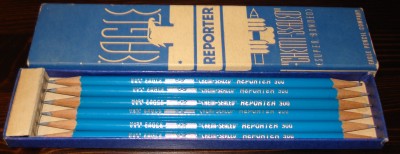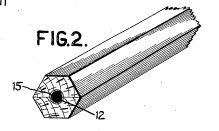
The Eagle Reporter is a pencil aimed at professional stenographers and reporters. Though the Reporter is no longer made, the tradition continues with modern pencils like the Faber-Castell 9008, a round version of the 9000 aimed at stenographers.
The pencils are a shiny aqua-blue and are marked:”Made in U.S.A. Eagle “Chemi-Sealed” Reporter 300″.
The box has a four paragraph writeup on the pencils, which begins “Stenographers and Reporters have long approved the thin diameter and special lead of these superb pencils.” Two Eagle pencil patents are mentioned.
Apart from artists and carpenters, do any other professions today have pencils made for them? I can’t think of any. There are special pencils for marking film, x-rays and other surfaces, but they’re not graphite writing pencils.
Let’s get to a distinguishing feature: They were sold pre-sharpened at both ends. A very practical response to the need to sharpen the point, that I haven’t seen elsewhere. It does make the pencil quite pocket-unfriendly though. Only slightly less obvious is how thin these pencils are. Vintage woodcase pencils are generally thicker than modern pencils, but these are the opposite. The leads appear greyer than any modern graphite core – more about this later.
As a writer, the pencil puts down a nice dark line which seems unexpected from the delicate looking pencil. The core does seem very strong and can take all the pressure I would want to give a pencil.
The patents seemed like an interesting aspect of the pencil. Luckily, I’ve found that the U.S. patent office is online and searchable.
I looked them up and was delighted – they’re not written in legal gibberish, are quite readable and brief, and have some excellent drawings.

The first patent is 1,854,905, Pencil and Method of Making Pencils by Charles Kaiser, Sr., filed November 25, 1929. The essential idea is strengthening the pencil casing by varnishing the pencil slats with copal. I had never previously heard of copal. It is a tree resin with a significant cultural history. There is an interesting paper on copal here. The terminology is different than today – a pencil casing is called a “sheath”, and a slat is called a “blank”.
The second patent is 1,892,508, Lead Pencil and Method of Making the Same by Narciso Gonzalez, filed March 27, 1931. The patent mentions that pencil leads typically contain tallow or stearic acid, and are thus greasy. This in turn intereferes with glue used to bind the lead to the pencil case. The problem is solved by first dipping the lead in sulphuric acid, washing it with water, then a second exposure is given, this time to diluted sulphuric acid, while a salt solution is applied. The glue then has a much easier time bonding to the lead.
Tallow being a pencil lead ingredient is news to me. I have no idea how widespread these techniques were in the industry when the Reporter was on the market, or if they’re still around today, but these patents demonstrate some of the research that has gone into making these everyday items so functional.

Interesting stuff . . .
both ends sharpened meant twice as long between sharpening…. maximizing the available pencil…
Dear sir,
We are a leading manufacturer of pencil cases in China,knowing you are a factory of pencils,so i think maybe we can cooperate.Do you think so?
Our pencil case are designed novelty,you can find it in our website or directly email to me.You will get a surprise from us.
Thanking you
Tina
I just bought a box of these at an antique store.
I’m curious about the use of pencils by news reporters. Did they really use pencils as opposed to other writing implements? Did they go out on assignments with several pencils so they would have a sharp point at the ready?
The use of pencils by stenographers intrigues me because by profession I am a certified shorthand reporter. I use a stenotype machine, but I have met a few so-called “pen writers,” and the all used pens. My mother in at least one of her jobs wrote shorthand, also with a pen.
Many years ago I read something, an ad perhaps, that referred to a certain pencil as a favorite of reporters.
There are some marvelous old Esterbrook fountain pens that have Gregg Shorthand nibs.
My mother was an illustrator and my father a newspaper editor in the 50s so pencils were beloved tools in our home. I would love to find the pencil supplied to reporters when I started in the mid-60s. It was much larger around and longer than these, with very soft lead and no eraser. The casing was shiny black and all the manual pencil sharpeners then had two hole sizes, one of which fit these and probably the fat pencils children used too. We took notes fast and furiously — no recorders back then– into a unique notebook about 2/3 the width of a steno pad, wide-ruled, an inch or two thick and cloth-bound at the top. The lines of notes were short, dark enough to read in poor light, and the ease in writing resembled most a bold black gel pen today. And yes, the bottom of my purse was always littered with extra pencils.
Into the 80s I still used these pencils to draw page layouts for newspapers.
To the comment on stenography, also yes, I used a pencil or a modern fountain pen with replaceable cartridges when taking dictation. Anything that didn’t require a lot of pressure or care, which slowed you down. I never took notes in shorthand, though, as a reporter because our notes were the source record and no editors could read shorthand.
Reporters and stenographers used pencils before ball point pens, and pencils are more portable than fountain pens. When I was a stenographer I liked fountain pens that were “broken in,” with a nib adapted to my hand, and I liked the skinny pencils and kept them around for when I ran out of ink or needed to use both sides of the steno paper.
Reporters used long narrow notepads, too, but I don’t know why. These seemed narrower than they needed to be to fit into a coat pocket.
I am not sure when fountain pens went from dip pens to having cartridges, but that may have something to do with it, too.
“Apart from artists and carpenters, do any other professions today have pencils made for them?”
Traditionally, architects & engineers. The whole Eagle Turquoise, Faber Castell “Techno-tone”, Eberhard Faber “Van-Dyke/Microtomic”, Venus Drawing leads, Dixon “El-Dorado”, and of course Koh-i-noor had a whole line of leads. And Steadler Mars.
Nowadays really only the Berol “Turquoise”, Steadler Mars “lumigraph” and “Isomars”, Koh-I-Noor “Triograph”, Faber Castell “9000”, Dixon’s General Drafting, Faber Castell “9000”, “TK 9400”, Mitsubishi-Uni(ball) “Hi-uni”, “9800” , “9000”, Tombow “mono 100″, and of course pentel, but only lead holders.
Typically you had 3 products marketed towards that market:
>Traditional wood cased pencils, in every grade but particularly with more options in hard lead for laying out.
>”Drawing Leads” aka plain graphite with chuck pencils.
>Mark Up colored pencils or grease pencils, in cased or plain leads, usually similar but not the same as colored pencils and leads from the same manufacturer.
>Sometimes you’d see a nonphoto blue marketed for use to this demographic.
>Or specialized lead with plastic copolymers, for use in drawing on mylar and acetate plastic film after the 50’s.
The qualities most draftsmen of the time wanted from a pencil, besides every grade of softness and hardness, was:
>Smoothness in drawing/writing: you don’t want a pencil that’s going to skip and jump on a drawing paper with tooth, and make inconsistent lines, likewise it shouldn’t be too physically hard to bruise the paper/bristol board, or tear very thin “onion skin” trace.
>Opacity: until the 80’s, most pencil drawings may have been reproduced with opto-chemical processes and you needed it to be opaque to UV light so that you got a good print.
>Fine granularity: the graininess of the line needed to be pretty much nonexistent both for the above repro process reason, and also for an image contrast reason. Also the fine grain was needed for good rendition when these pencils were used for shading and rendering, so smudging sticks wouldn’t be needed.
>Low smudging: when possible, the desire was for a graphite that wouldn’t smudge a lot once on the paper. Despite that it still was liable to smudge, and a lot of time was invested in dry cleaning powder, drafting shields, and other methods to keep the paper clean.
>Point keeping: In wood cased pencils and leads, the lead was contradictorily also desired to be fairly hard to keep a fine point longer, to reduce the amount of sharpening or “pointing up” with abrasive paper. (Thin lead mechanical pencils trade off this quality for being physically smaller, but that means you need more pencils to get a range of line sizes, & hardness.)
So many of these leads used wax added in like the Blackwings, to make the lead self lubricating, while also still having a good firmness to the lead to keep it from breaking to easily, and still maintaining a fairly fine grained lead. That fine grain was a marketing reason for “Electronic graphite” in Eagle Turquoise, and “Microtomic” in Eberhardt Faber’s marketing. Contemporary drafting leads usually are not as good in this area, such as berol turquoise leads, which are fairly greasy instead of waxy. (best in current production imo is the Mitsubishi-Uni and their lead holders are the correct weight and correctly balanced on center, not nose heavy. Best historically are the Eagle-Turquoise before they switched to plastic containers).
With print marking leads, usually they’re optimized for good contrast and opacity so it stands out against cyanotypes (blue prints), and van dyke-prints. This is where to see the grease pencil leads like listo, which outlived this application; but also the denser waxy pencils and leads, such as the verithins, and prismacolors. Eagle had a dedicated line of print marking leads. And Venus Pencil had a whole line of “Blueprint Marking Pencils” usually in yellow or red for reviewers to markup prints and make comments.
With computerization, the whole drafting market kinda bottomed out, and those that remain are mostly cheaper (not really better). So most of what you see is aimed more at artists and less at Architects and Engineers. The few that still use these products are students on a budget, or professionals that still work in traditional media.